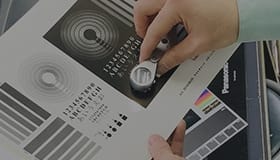Screen printing
-
What is screen printing?
-
Screen printing is a type of stencil printing which uses a technique of duplicating the image from a design made on mesh stencils.
When printing ink goes through the mesh, it transfers the image onto the substrate material. Other than air and water, any substrate materials are printable. Not only flat surfaces, but also curved, specially shaped, and molded products are suitable for screen printing.
-
When we extended the primary drying time, pinholes and cracks resulted. How can we eliminate them?
-
With one-pot inks, if the primary drying time is too long, the solvent of second ink penetrates the first color layer and makes pinholes.
With two-pot inks, if the primary drying time is too long, a curing process occurs. Thus when the second color is printed, the first color ink layer wrinkles and looks like cracks. The countermeasure in either case would be to shorten the primary drying time.
-
Why there is “Primary” drying and “Final” drying?
-
Residual solvent at the time of injection may cause ink flow and insufficient adhesion. To prevent these malfunctions, residual solvent must be evaporated through a “Final” drying process.
-
What are the standard drying conditions?
-
In multi-color printing, primary drying would be done after each color is printed. After the final color is printed, the final drying should be done according to the conditions listed in the catalog. If the color printed ink is a “two-pot” ink the final drying should be done after the printing of the Binder.
-
When over-printed with a black ink, we often have pinholes. How can we eliminate the pinholes?
-
See the list below for causes of pinholes:
1. The first layer is too thin (less than 5 µ)
2. Too much dilution of the ink (more than 20%)
3. Too much squeegee pressure
4. Under layer is pale colored, such as a medium based color
5. Any combination of these causes

